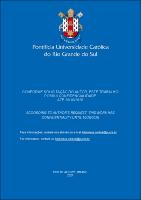| Share record |


|
Please use this identifier to cite or link to this item:
https://tede2.pucrs.br/tede2/handle/tede/9930| Document type: | Tese |
| Title: | Adaptação e validação da family health behavior scale para uso no Brasil |
| Author: | Preto, Luiza Tweedie  |
| Advisor: | Mattiello, Rita |
| Abstract (native): | Introdução: O ambiente familiar tem sido apresentado como um dos principais fatores que contribuem para a obesidade infantil. Apesar disso, há uma escassez de instrumentos disponíveis para avaliar os comportamentos da saúde da família. Dentro dos instrumentos disponíveis, a "Family health behavior scale" pode ser considerada uma ferramenta completa e viável para avaliar os comportamentos de saúde de pais e filhos, rotinas de refeições e atividades físicas da família por meio de um questionário de apenas 27 itens, de fácil compreensão. Objetivos: Validar a escala "Family Health Behavior Scale" em português para uso em crianças brasileiras. Métodos: A amostra incluiu 273 crianças de cinco a 12 anos e os seus responsáveis responderam à “Family health behavior scale”. Além do uso desta ferramenta, foram realizadas as medidas antropométricas de peso e da altura das crianças, fez-se o exame de bioimpedância para avaliar o percentual de gordura corporal e a avaliação quanto à prática de atividade física. Para o processo de validação da escala, primeiro se efetuou a tradução e a adaptação; depois, testou-se as propriedades psicométricas de validade (de conteúdo, de construto e concorrente) e confiabilidade (consistência interna, efeito de teto e teste-reteste). Resultados: foram testadas 272 crianças (54% meninas) com idade média de 7,9 anos (DP = 2,0) e seus cuidadores. A análise fatorial exploratória mostrou o índice de Kaiser-Meyer-Olkin = 0,79. As crianças consideradas obesas apresentaram escores totais médios mais baixos do que as crianças com peso saudável ou com sobrepeso. As crianças que foram classificadas como tendo um percentual de gordura saudável tiveram escores mais altos do que as crianças classificadas como tendo um percentual de gordura excessivamente alto. Crianças fisicamente ativas apresentaram escores totais significativamente maiores do que crianças fisicamente inativas. O alfa de Cronbach foi de 0,81. As análises de teste-reteste mostraram menor concordância e coeficientes de correlação intraclasse do que o esperado 0,63 (IC 95% 0,41 a 0,78). Conclusão: Constatou-se que essa escala é uma ferramenta útil tanto para a prática clínica quanto para a pesquisa de campo da população em estudo, com o objetivo de auxiliar na prevenção da obesidade infantil. |
| Abstract (english): | Background: It is known that the family environment has been presented as one of the main factors that contribute to childhood obesity. Despite this, there is a scarcity of instruments available to assess family health behaviors, the "Family health behavior scale" can be considered a complete and feasible tool to assess health behaviors of parents and children, meal routines and activity family physics through a questionnaire of only 27 items that is easy to understand. Objetive: To validate the scale "Family health behavior scale" in Portuguese for use in Brazilian children. Methods: The sample included 273 children aged 5 to 12 years. Where those responsible for the child responded to the Family health behavior scale, in addition to the scale, anthropometric measurements of the children's weight and height were performed, as well as the bioimpedance exam in order to assess the percentage of body fat. Children were also assessed for physical activity. For the scale validation process, translation and adaptation were first performed, then the psychometric validation properties (content validity, construct validity and concurrent validity) and reliability (internal consistency, ceiling-floor effect and test-retest). Results: 272 children (54% girls) with a mean age of 7.9 years (SD=2.0) and their caregivers were tested. Exploratory factor analysis showed the Kaiser-Meyer-Olkin index = 0.79. Children who were considered obese had lower mean total scores than children who had a healthy weight or were overweight. Children who were classified as having a healthy fat percentage had higher scores than children classified as having an excessively high fat percentage. Children who were physically active had significantly higher total scores than children who were physically inactive. Cronbach's alpha was 0.81. Test-retest analyses showed lower agreement and intraclass correlation coefficients than expected 0.63 (95% CI 0.41 to 0.78). Conclusion: Thus, we found that this scale is a useful tool both for clinical practice and for field research of our population with the aim of assisting in the prevention of childhood obesity. |
| Keywords: | Obesidade Infantil Alimentação Atividade Física Tradução Validação Childhood Obesity Feeding Physical Activity Translation Validation |
| CNPQ Knowledge Areas: | CIENCIAS DA SAUDE::MEDICINA MEDICINA::SAUDE MATERNO-INFANTIL |
| Language: | por |
| Country: | Brasil |
| Publisher: | Pontifícia Universidade Católica do Rio Grande do Sul |
| Institution Acronym: | PUCRS |
| Department: | Escola de Medicina |
| Program: | Programa de Pós-Graduação em Medicina/Pediatria e Saúde da Criança |
| Access type: | Acesso Aberto |
| Fulltext access restriction: | Trabalho será publicado como artigo ou livro |
| Time to release fulltext: | 60 meses |
| Date to release fulltext: | 26/10/2026 |
| URI: | http://tede2.pucrs.br/tede2/handle/tede/9930 |
| Issue Date: | 25-Mar-2020 |
| Appears in Collections: | Programa de Pós-Graduação em Pediatria e Saúde da Criança |
Files in This Item:
| File | Description | Size | Format | |
|---|---|---|---|---|
| TES_LUIZA_TWEEDIE_PRETO_CONFIDENCIAL.pdf | LUIZA_TWEEDIE_PRETO_TES | 307.77 kB | Adobe PDF |  Download/Open Preview |
Items in DSpace are protected by copyright, with all rights reserved, unless otherwise indicated.




